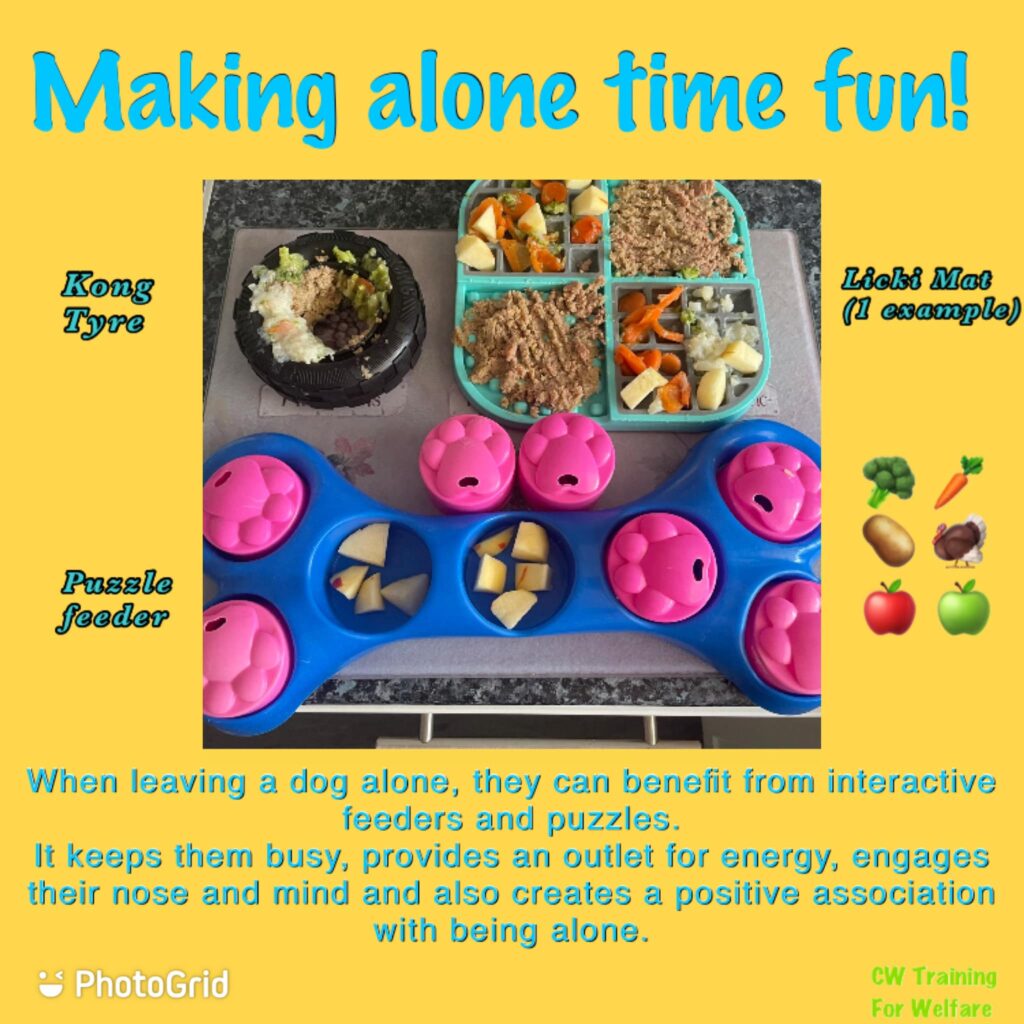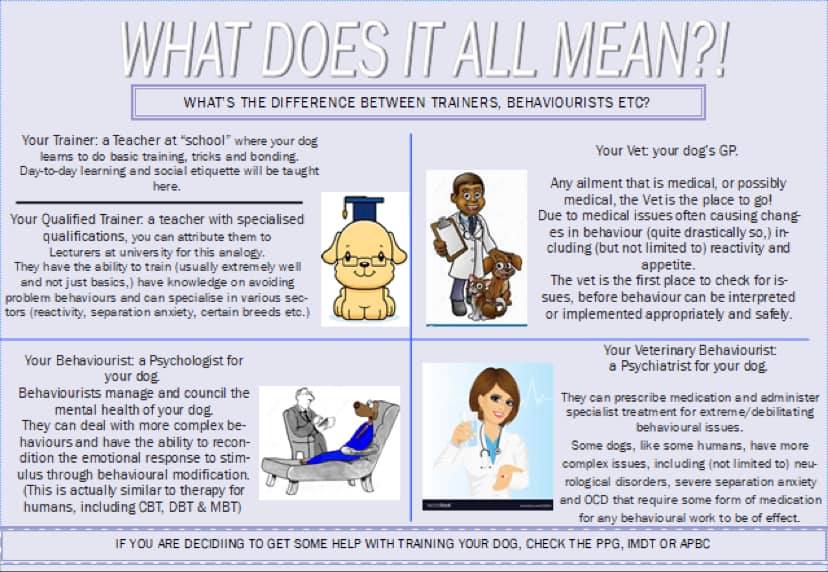Separation Anxiety and Training Information and training plan for separation training.
The importance of separation training is very much down to your dog’s confidence in being away from you. It is mentally and emotionally beneficial to build this skill in any dog.

Rescue dogs generally have an element of separation anxiety. For the first few months they are getting used to everything all at the same time and stress levels are high.
You are all so nice to them and build intimate bonds. This means that they will attach.
Dogs are naturally wired to attach to humans. I’m not joking, there has been studies of dogs and wolves, raised in identical settings with the same socialising. However, they show completely different behaviour when it comes to humans. Dogs are naturally in tune with our body language and facial expressions and will seek out our company. Wolves, on the other hand, stay vigilant, untrusting and unable to properly read us.
There have also been studies in stray dog populations across the world; showing their ability to read human body language, even without the amount of interaction that dogs would usually get in a pet setting.
The fact that they are so able to attach to us and bond means that they often need our company.
The recommended length of time to leave a dog now is approximately four hours.
They really do strive for human companionship. With time in training they can learn that being on their own is okay.
You can read about this in the following articles:

First rule: MAKE SURE IT’S REALLY SEPARATION ANXIETY!
We must rule out other potential causes for a dog being reactive alone. Some reasons for unsettled behaviour include:
The first port of call is a veterinary check, to ensure the dog is not in any pain or ill, this is especially important for a settled dog whom is displaying out-of-character behaviour.
Next we need to examine what is setting the reaction off; when it happens, the daily routine up until they’re left and the conditions they are left in.
Separation training is quite literally what it says on the tin. We are going to avoid negative associations building up & replace them with positive ones. This means that we cannot leave the dog alone (unless scheduled training), especially to be stressed as that will only create more negative associations, interfering with us building up the positives.
So, some people find it sweet that their pups follow them around the home. Yes, it is lovely, very sweet… at first!
After a while though, this means that the pup has energy that they could be using on something else. It also means that whatever they do would keep them in one place and make other areas of the home more valuable than following you around. This is the start of separation training.
I usually advise for meals to be used because they are a regular, positive amount of time that can be consistent for some training. Whilst your dog eats, practice leaving the room and coming back. Over and over again.
To us it’s tedious but the repetition gives the dog a clear routine and using meals distracts them from the reality of being *alone*, building a very positive association with the action moving forward. Once the dog is more okay with being left in a room, you can start to extend this.
Using meals as enrichment opportunities affords you more time to get training in but you can also use longer lasting chews etc once you build the distance and duration.
Settle your dog regularly with chews and low arousal activities to encourage calmer behaviour and healthy amounts of sleep.
Go further away from your dog whilst they are doing these things, start with upstairs perhaps, then the porch, the garden and so on. This is very specific to the individual dog so some may skip steps and others may need more reinforcement at lower levels of stress to keep the conditioning stable.
Then you can leave the home and come back regularly too.
If your dog is only not okay when you are not in the house then it is imperative to get a video of your dog’s behaviour when alone. You can get an indoor camera, use Alexa, FaceTime another phone, Zoom call your computer/laptop etc. – we need to see what is going on when the dog is alone, to ensure that we can rule out any other issues that may be happening.
If done, then proceed:
(Tip; if your dog likes chewing skirting boards/table legs, then get them antlers and any chews/toys that mimic wood. If your dog likes to chew things that make noise then try to mimic this, you can get toys that mimic the scrunching of plastic/squeaking etc.)
Every time you leave, you want to come back before the dog becomes anxious or stressed. This will build up small positive associations with the action, therefore changing the underlying emotional response over time. Then extend the time at the dog’s pace.
Lastly, there is another type of separation anxiety, which stems from a hyper-attachment to one family member. If a dog becomes unsettled when only one member of the home is absent, look at who is undertaking the primary care of the dog (feeding, walking, training, toileting etc.)
It is good practice to share the responsibilities of care so that the dog can form stronger, individual bonds with the household members. This includes getting children involved (individually) in training once or twice a week each (more for solo children) so that both human & canine can form those bonds and positive associations between the two.
With time in training they can learn that being on their own is okay.
One last thing to remember about separation anxiety is that every part of your leaving routine can become part of the association for the dog. We call this poisoning cues and behaviours through association. You may see dog start to get unsettled or overstimulated when you begin what you do. Most go something like this:
To avoid doing this you would:
An important part of behavioural reconditioning in dogs is keeping them below an emotional threshold which means ensuring that they are not stressed and producing high levels of cortisol especially.
Due to it taking approximately three days for those levels to balance in the blood is very easy for the dog to be on edge and reactive during this time.
Behavioural reconditioning cannot happen in this state so we need to bring the dog back down to a calm level again, we do this through enrichment, mental stimulation and species (and breed) specific outlets.
If a dog is simply too stressed for anything to change, medication can be prescribed by your vet or you can have a referral to a veterinary behaviourist. (Lots of insurances cover behaviour work so take a look at your terms and conditions.)
The effects of these medications are similar in dogs to humans, i’m bringing their brain chemistry down to a level where behavioural reconditioning will have the optimum effect.
Not all dogs have to stay on the medication for their lives, many can come off once the behavioural reconditioning has been actioned, this is a big reason why it’s important to keep in touch with the medical personnel in charge of the dogs care on medication.
A veterinary behaviourist is somebody with expertise in the psychological and biological sides of canine care. Please see the diagram below to explain the differences between the various titles in the dog training world.

Our thanks go to Cleo Wiltshire (FF Level 4 Trainer/Behaviour Consultant) for writing this guide for us.
We hope your have found this guide on Separation Anxiety and Training useful. You can see other help guides here: Dog Training guides.